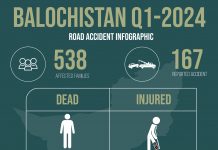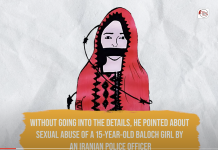Abstract
History testifies that the weaker States have always served as a buffer zone among formidable confronting States. The weaker States have been exploited to fulfil the vested interests of powerful nations.
This Article investigates how and why Balochistan territory was used by the colonial power to halt the advancing Russia into the heart of Subcontinent. The colonial power, the British used various tactics to hold its sway in Balochistan. The colonial power adopted a policy of noninterference in Balochistan.
However, the circumstances compelled the great British to annex Balochistan. Moreover, throughout this era, the big power neglected the human rights of the common people. The people of Balochistan suffered hardships due to the international rivalry. Furthermore, the incapable Sardars of Balochistan served the colonial masters at the expense of common people.
Introduction
Balochistan has always attracted European Nations for its strategic location as it lies on the crossroads, of the routes connecting Central Asia, The Middle East and South Asia. Since Peter the Great (1672- 1725), the Russian wanted access to warm waters. After many futile efforts to control the Dardanelles which was guarded by Turkey, Russians ordered to find a route to the Persian Gulf and the Indian Ocean.
At the end of the eighteenth century, the Russians had captured most of the Central Asian land and had started sending diplomats to Iran, Afghanistan, Sindh and the Punjab. Apart from that, Napoleon invasion of Egypt in 1798 and his diplomat’s missions to Shah of Iran and Tipu Sultan of Mysore had threatened the British interests in the Sub-continent.
Although the Battle of Waterloo in 1815, diminished the French threat, Russian expansions remained a Herculean task for the British. Thus, counter policies adopted by the British to contain Russian threat in the nineteenth century were the main causes of the British advent in Balochistan. The political and diplomatic encounter in the nineteenth century between Russian and British over Afghanistan and surrounding countries is termed as Great Game. In order to keep Russians at bay, the English wanted to conquer Afghanistan and used it as buffer State between them. In pursuit of this objective, the British followed either non-interference or forward policy according to factors and circumstances.
This paper will focus on the factors which led to the advent of the British in Balochistan and its aftermath results.
Balochistan & First Afghan War
One of counter policies of the British to halt Russians advance was to enhance trade relations with Central Asians. For this purpose, the British Government planned to open the river Indus for commercial purpose. The British Government concluded treaties with Mir’s of Sindh & Maharaja Ranjit (Ruler of Punjab). Governor General Alexander Burmes Amir Dost Muhammad of Kabul to seal a treaty, but he failed.
Owing to Kabul’s claim on Peshawar, against Sikhs the ally of the British Government. “Fascinatingly, on December 19, 1837, a Russian diplomat, Cap Ivan Vickovich arrived at Kabul with letters from Czar for the same purpose that Burnes had come.”(Norris: 1967:13) It put Dost Muhammad at horns of the dilemma, but he negotiated with the letter. This failure compelled the British Government to conclude tri party treaty. This treaty was signed
This treaty was signed among the British Government, Ranjit Singh and Shah Shuja (deposed King) of Afghanistan on (June 1838). The terms of the treaty were that the Sikh & the British would help Shah Shuja to capture throne in Kabul. In return, Shah Shuja would recognize the Sikh Government in Punjab, NWFP & Peshawar and Kashmir.
Consequently, the British raised a large military force known as “Army of Indus.”(Embree: 1979:30) At ferozpur, when the time come for the army to attack Afghanistan, Ranjit Singh not only reneged upon his pledge but also declined to allow Lt. General I. Keane, commandant of the Indus army to march through his land. General Keane had to find out an alternate route through Sindh and Balochistan.
As a result, the British signed a treaty on (March 1839) with the Khan of Kalat. Khan assured them of his support. “General took Qandahar on April 26 and captured Ghazni on July 22, 1839. On August 7, 1839, the army entered Kabul along with Shah Shuja without any resistance, Dost Muhammad fled to Bokhara.”(Louis: 1977:378) During this period, two events took place that changed the future of Balochistan. First, Ranjit died in 1839. It increased the possibilities of capturing Punjab. Second, to strengthen Shah Shuja, the British Government took every possible step but all in vain.
Finally, in predicament, the British decided to pull out its troops, and it was a foolish plan that produced disastrous results. Besides freezing weather, the attacks of native people made their retreat one of humiliating and bloody in the history of wars. “Dr Brydon was the sole survivor of the war.”(Baluchistan: 375-76)
Treaties & Fate of Balochistan
The humiliating results of First Afghan war proved to be even more disastrous for Sindh & Balochistan. Now, the British had realized the importance of both these areas for their Afghan and Central Asia policy. They were well aware of the internal weaknesses of Balochistan; therefore, they compelled the Khan to conclude various treaties with the British.
The first treaty was signed on March 28, 1839. According to treaty “Khan had to provide safe passage and supplies to the Army of Indus on way to
According to treaty “Khan had to provide safe passage and supplies to the Army of Indus on way to Qandahar, and would acknowledge the supremacy of Shah Shuja. In return, the British Government would provide a subsidy of Rs. 150,000 annually.”(Ahmedzai: 57-58)
However, the army faced problems while passing through Bolan. It was alleged that Muhammad Hassan was bent on to create a feeling of distrust between the British & Khan. Muhammad Hassan succeeded in his notorious designs.
The British held Mir Mehrab Khan of Kalat (1817-1839) responsible for the violation and the British troops attacked Kalat on Nov 13, 1839. Khan was killed while fighting. The British insulted a teenager, Shah Nawaz Khan, a distant relative of Mehrab as a new ruler with Lt. Love day as Regent. “The Regent started vivisection of Balochistan by giving Quetta & Mastung to Shah Shuja and Kachi to the rulers of Sindh. But as soon as the British forces left Kalat, the tribal Sardars revolted and Nasir Khan II (1840- 1857) son of Mehrab Khan was enthroned.”(Awan: 1958:62)
Policy of Non-Interference
After consecutive failures in Afghanistan and Balochistan, the British realized that rather than occupying Balochistan, the British Government should strengthen Khan, and adopt a policy of noninterference.
For this purpose, the British Government signed a treaty on October 6, 1841, with Khan of Kalat. The treaty stipulated that Nasir Khan II as Khan of Balochistan, and Khan agreed to be a vassal of Shah Shuja and British. The dismembered areas of Kalat State were restored. When Shah Shuja was murdered in 1842, the British concentrated on Sindh and Punjab and adopted forward policy toward them.
Balochistan as an Independent Ally
The volatile and deteriorated law and order situation in Afghanistan attracted Iran to invade it. Iran succeeded in occupying Herat in 1853 with the help of Russian. It was a clear move on part of Russians to realizing the changing dynamics of politics in the region and concluded a treaty with Khan Nasir Khan II on May 4, 1854. This treaty abrogated the treaty of 1841.
The new treaty recognized the Nasir Khan II as an Independent ruler, whereas he was expected to oppose the enemies of the British and to be friendly with their supporters. Khan became a close ally of the British in the region by the said treaty. In return, the British Government provide military support to Khan and an annual subsidy of Rs. 50,000. This treaty was signed at Mastung.
According to a British source “in 1854, when war was anticipated between England and Russia, to strengthen the position on the frontier, a fresh treaty was made” (Report: 1886:4). This aforesaid treaty was further strengthened in 1862, when the boundary between Balochistan and British India was defined and Kalat was accepted as a neighbouring State of India.
Moreover, the annual subsidy was also doubled. The very next year, another treaty was brokered in 1863. According to treaty Khan was bound to protect British interests and would safeguard the British cantonments. “The British Government in return would pay 20, 5000 Rupees per annum to Khan for the establishment of posts and development of traffic along the trade routes. (Aitchison: 357-358).
The basic objective behind these treaties was to watch the British’s interests. The British Government succeeded in building pressure on the Russians not to come close to British India’s frontiers. Moreover, the British Government helped Khan to secure his position internally and externally. The aim of subsidy was to strengthen the Khan’s position in Balochistan against rebel Sardars.
However, after the death of Mir Nasir Khan II, the political situation in Balochistan changed. “Mir Khudaidad Khan, the youngest brother of Mir Nasir Khan II was elected as new Khan, and he was supported by the British Government. In 1858, the British Government supported the Khan against the rebel Chief Sardar Azad Khan of Kharan, Jam of Bela, and the Marri tribe.” (Baloch: 1987:133)
With the help and dictation of the British Government, Khan went to Makhran to quash the rebellion and consolidate his authority. Khan raised a huge army with the colonial support. It was the result of standing army that Khan strengthened his authority. Khan confiscated lands from those Sardars who had left in the lurch to help Mir Mehrab Khan in 1839.
The strict action of Khan fanned the forces of unrest among the Sardars, and finally, a civil war broke out. During the civil war, the British Government indirectly supported the Khan, against the Sardars. The British never wanted to intervene in the internal affairs of any State, as he was bound by aforesaid treaties. There emerged two schools of thoughts with regard to dealing Balochistan problem.
One school of thought claimed that Khan’s position needed to be secured. As the British Government had concluded all treaties with the Khan alone. By supporting his central authority the centrifugal forces could be foiled. The British should not support the subjects and petty fiefs over Khan. This school of thought viewed Khan as the only protector of the British’s interests in the region.
Whereas, other school of thought believed that the British Government should go for Forward Policy to settle the dispute in Balochistan. The Chief proponent of this policy was Captain Sandeman, a Punjab political officer of district Dera Ghazi Khan. He favoured this policy and suggested the British Government to directly intervene and settle the civil war between the Khan and Sardars.
Mithonkot Conference (1871)
In order to solve the problem, Lord Mayo’s Government directed “the government of Punjab and Bombay to convene a joint meeting to settle the differences between those who favoured a strong central authority and those who advocated Federation and intervention in the internal affairs of Balochistan.”
The conference was held at Mithonkot on Feb 3, 1871, between the representatives of two viewpoints. The conference agreed upon the full control by Sindh Government of the affairs of Balochistan. They recommended as following:
- The affairs of Balochistan should be conducted through the Khan and not through the Chiefs.
- Peace should be maintained through the employment of tribal horseman for protecting the trade routes.
- All the payments to Baloch Chiefs should be given in the name of the Khan.
The Mithonkot conference openly supported Khan’s authority over tribal Chiefs. This attitude of the British Government added fuel to fire and instigated civil war which lasted until 1876. During the civil war, the Chiefs submitted different recommendations,
- Khan should reintroduce the constitution of Nasir Khan II.
- Khan should dismantle the standing army.
- Khan should not interfere in the tribal provinces.
- The Prime Minister should be elected by the Chiefs.”
Khan at once turned down these demands. He never wanted to share power with his subjects (Chiefs).
The Forward Policy
Sir Robert Sandeman was appointed as a political officer of Dera Ghazi Khan District. He was a proponent of Forward Policy in Balochistan. He was well aware of the intra tribal jealousies, and weakness of the tribal system. He controlled the unstable Derajat through muscle and bribe. He bribed the rebel Baloch tribesman to garner their support for a peaceful environment. His bribe to Baloch tribes worked and he succeeded in bringing them under the British control.
Furthermore, he wanted to expand the British’s authority over Balochistan. However, his views were always rejected by the administrators of Sindh. Sandeman opposed a strong centre under Khan. Whereas, administrator of Sindh supported strong central government under Khan in Balochistan.
The Mithonkot conference was the culmination of administrator’s of Sindh’s Stance. However, Sandeman never stopped from pursuing his “Forward Policy” in Balochistan.
In 1876, Lord Lyton was appointed as new viceroy of India. He supported Sandeman’s forward policy in Balochistan and Afghanistan. When Sandeman got official backing, he went to Kalat to put an end to the internecine war between Khan and Sardars on behalf of the British Government. Moreover, he was advised to help conclude a new treaty between Khan of Kalat and Lord Lyton. He succeeded in his mission.
On 8th December 1876 a treaty was signed between Lord Lyton and Khan at Jacobabad, known as Jacobabad treaty. This treaty acknowledged Khan as a sovereign ruler but subservient in external affairs to the British Government. Hence the Jacobabad agreement (1876) smothered the path for the peaceful annexation of Balochistan. And with the seizure of Balochistan, the British Government introduced Sandeman System in Balochistan. The levy system and Jirga system were part of Sandeman policies in Balochistan.
Conclusions
To conclude, Balochistan’s strategic location has always appealed imperialist power throughout history. For the first time, Balochistan came into the limelight of imperialist power since the nineteenth century. The Russians wanted access to warm waters, while it was seen as a threat to the British Government in India.
In order to avoid such threats, the British Government in India adopted political, diplomatic and military options to stop Russian expansion. In this way, by default, Balochistan fate was sealed. Firstly, the Britisher signed different treatise with Khan to support them in their adventure, but soon the Britisher realized the schism in the Kalat State.
The Internal rivalry between the Khan and Sardars provided an opportunity to annex Balochistan. Resultantly Sandeman system was introduced in Baluchistan that transformed the socio-political history of Kalat state.
References
Norris J.I,(1976) The First Afghan War, 1838-42, Cambridge .134.
Embree A.T (1979) ed. Pakistan’s western Borderlands, Karachi.30-31.
Louis Dupree (1977) Afghanistan, karachi .378.
Balochistan and The First Afghan War, P.375-76.
Ahmedzai, Tarikh-i-Baloch, Vol. VI, P.57-58.
Awan A.B(1958) Balochistan, Historical and Political Processes, London.62.
First Administration Report of the Balochistan Agency (Calcuta, 1886) P.4.
Aitchison, A Collection of Treaties, Vol. XI, P.357-58.
Baloch, Inayatullah (1987) The Problems of Greater Balochistan, Germany.133-138
Dr Saeeda Mengal is an Assistant Professor at Department of History in the University of Balochistan. This research paper was first published in annual research journal Al-burrz.






























